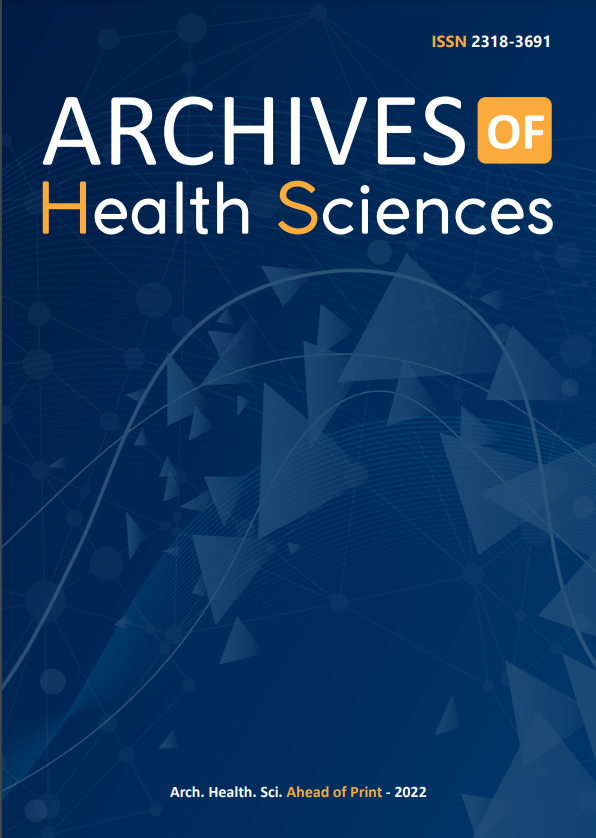Prevalence of bone disease and renal lithiasis in patients with primary hyperparathyroidism
DOI:
https://doi.org/10.17696/2318-3691.29.1.2022.1798Keywords:
Osteoporosis, Hyperparathyroidism, Primary, NephrolithiasisAbstract
Introduction: The diagnostic of primary hyperparathyroidism (PHTP) improved lastly identify the asymptomatic and normocalcemic form characterized by mild hypercalcemia and normal serum calcium, respectively. Objective: to identify the epidemiologic profile and establish the prevalence of bone disease and renal lithiasis in patients with primary hyperparathyroidism treated at a tertiary outpatient center at Sao Paulo state, Brazil. Methods: retrospective analysis of the medical records of patients treated at the outpatient clinic from July 2015 to June 2016 with diagnosis of PHPT (44 patients). Considering the presence of hypercalcemia, two groups of patients were caracterized: with hypercalcemia (n=36) and normocalcemia (n=8). Data from laboratory and imaging tests were evaluated. Results: The hypercalcemic group showed a mean age higher and a lower kidney function than the normocalcemic one. The low bone mass was present in both groups hypercalcemic and normocalcemic with prevalence of 82% and 62.5% and osteoporosis of 57.6% and 37.5%, respectively. Renal lithiasis, analyzed by renal ultrasound, was identified in 42% and 66.6% of the hypercalcemic and normocalcemic groups, respectively. Conclusion: osteoporosis and renal lithiasis are frequent in HPTP in both hypercalcemic and normocalcemic forms. Appropriate approach to patients with this morbidity can prevent bone and kidney disorders.References
Silva BC, Cusano NE, Bilezikian JP. Primary hyperparathyroidism. Best Pract Res Clin Endocrinol Metab. 2018;32(5):593-607. doi: 10.1016/j.beem.2018.09.004
Bilezikian JP, Cusano NE, Khan AA, Liu JM, Marcocci C, Bandeira F. Primary hyperparathyroidism. Nat Rev Dis Primers. 2016;2:16033. doi: 10.1038/nrdp.2016.33
Cusano NE, Cipriani C, Bilezikian JP. Management of normocalcemic primary hyperparathyroidism. Best Pract Res Clin Endocrinol Metab. 2018;32(6):837-45. doi: 10.1016/j.beem.2018.09.009
Kowalski GJ, Bula G, Zadlo D, Gawrychowska A, Gawrychowski J. Primary hyperparathyroidism. Endokrynol Polska. 2020;71(3):260-70. doi: 10.5603/EP.a2020.0028
Mantzoros I, Kyriakidou D, Glanos-Demiris K, Chatzakis C, Parpoudi S, Sapidis N, et al. A reare cause of primary hyperparathyroidism caused by a giant solitary parathyroid adenoma. Am J Case Rep. 2018;19:1334-7. doi: 10.12659/AJCR.911452
Gonçalves TD. EndoClínica [homepage na Internet]. 2019 [acesso em 2019 Jul 31]. Hiperparatireoidismo primário; [aproximadamente 1 tela]. Disponível em: https://www.endoclinicasp.com.br/artigo?l=hiperparatireoidismo-primario#conteudo
Khan AA, Hanley DA, Rizzoli R, Bollerslev J, Young JEM, Rejnmark L, et al. Primary hyperparathyroidism: review and recommendations on evaluarion, diagnosis, and management. A Canadian and international consensus. Osteoporosis Int. 2017;28(1):1-19. doi: 10.1007/s00198-016-3716-2
Lemos ALP, Andrade SRL, Pontes LLH, Teixeira PMC, Bandeira E, et al. High rate of occult urolithiasis in normocalcemic primary hyperparathyroidsm. Kidney Blood Press Res. 2019;44(5):1189-95. doi: 10.1159/000502578
Siprová H, FrysáK Z, Soucek M. Primary hyperparathryroidism, with a focus on management of the normocalcemic form: to treat or not to treat? Endocr Pract. 2016;22(3):294-301. doi: 10.4158/EP15704.OR
Cong X, Shen L, Gu X. Current opinions on neprholitiasis associated with primary hyperparathyroidism. Urolithiasis. 2018;46(5):435-57. doi: 10.1007/s00240-018-1038-x
Cipriani C, Biamonte F, Costa AG, Zhang C, Biondi P, Diacinti D, et al. Prevalence of kidney stones and vertebral fractures in primary hyperparathyroidism using imaging technology. J Clin Endocrinol Metab. 2015;100(4):1309-15. doi: 10.1210/jc.2014-3708
Aojula N, Khan S, Gittoes N, Hassan-Smith Z. Normocalcaemic primary hyperparathyroidism: what is the role of parathyroid surgery? Ther Adv Endocrinol Metab. 2021;12:1-10. doi: 10.1177/2042018821995370
Shini M, Jacques RM, Oakes E, Peel NFA, Walsh JS, Eastell R. Normocalcemic hyperparathyroidism: study of its prevalence and natural history. J Clin Endocrinol Metab. 2020;105(4):e1171-e1186. doi: 10.1210/clinem/dgaa084
Pierreux J, Bravenboer B. Normocalcemic primary hyperparathyroidism: a comparison with the hypercalcemic form in a tertiary referral population. Horm Metab Res. 2018;50(11):797-802. doi: 10.1055/a-0752-4533
Misgar RA, Sehgal A, Masoodi SR, Wani AI, Bashir MI, Malik AA, et al. A comparation between silent and symptomatic renal stones in primary hyperpatathyroidism. Indian J Endocrinol Metab. 2019;23(1):46-9. doi: 10.4103/ijem.IJEM_558_18
Behrens M, Boyle S, Fingeret AL. Evaluation for primary hyperparathyroidism in patients who present with nephrolithiasis. J Surg Res. 2021;257:79-84. doi: org/10.1016/j.jss.2020.07.049
Castellano E, Attanasio R, Boriano A, Borretta G. Clinical presentation of primary hyperparathyroidism in older adults. J Endocr Soc. 2019;3(12):2305-12. doi: org/10.1210/js.2019-00316
Buicko JL, Kichler KM, Amundson JR, Scurci S, Kozol RA. The sestamibi paradox: improving intraoperative localization of parathyroid adenomas. Am Surgeon. 2017;83(8):832-5. doi: 10.1177/000313481708300831
Downloads
Published
Issue
Section
License
Copyright (c) 2022 Archives of Health Sciences

This work is licensed under a Creative Commons Attribution-NonCommercial-NoDerivatives 4.0 International License.










